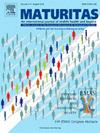老年人神经退行性变和炎症生物标志物与内在能力的性别特异性关联:来自4年纵向多域阿尔茨海默病预防试验(MAPT)的发现
IF 3.9
2区 医学
Q2 GERIATRICS & GERONTOLOGY
引用次数: 0
摘要
这项为期四年的纵向研究调查了炎症相关和神经退行性相关的血液生物标志物与内在容量的横断面和纵向关联是否因性别而异。样本包括1117名老年人(本文章由计算机程序翻译,如有差异,请以英文原文为准。
Sex-specific associations of neurodegeneration and inflammatory biomarkers with intrinsic capacity in older adults: Findings from the 4-year longitudinal Multidomain Alzheimer's Prevention Trial (MAPT)
This four-year longitudinal study investigated whether the cross-sectional and longitudinal associations of inflammation-related and neurodegenerative-related blood biomarkers with intrinsic capacity differ according to sex. The sample comprised 1117 older adults (<70 years, 63.8 % females) from the Multidomain Alzheimer's Prevention Trial (MAPT). The domains of intrinsic capacity were operationalized as cognition (Mini-Mental State Examination), locomotion (Short Physical Performance Battery), vitality (Handgrip Strength), and psychological well-being (Geriatric Depression Scale), each scaled from 0 (worst intrinsic capacity possible) to 100 (best intrinsic capacity possible). Plasma biomarkers included interleukin 6 (picograms per milliliter), growth differentiation factor-15 (picograms per milliliter), tumor necrosis factor receptor 1 (picograms per milliliter), neurofilament light chain (picograms per milliliter), progranulin (nanograms per milliliter), and amyloid-beta ratio. Linear mixed models were analyzed to examine whether sex modified the cross-sectional and longitudinal association between biomarkers and intrinsic capacity. No significant interaction effect was observed at baseline. Longitudinal analyses revealed a significant interaction between sex and interleukin 6 (p = .005), such that higher levels of interleukin 6 tended to be associated with a faster decline in intrinsic capacity for males (B = −0.385; p = .055; 95 % CI = −0.778; 0.008) but not for females (B = 0.287; p = .041; 95 % CI = 0.011; 0.563). The other biomarkers had no sex-dependent associations with intrinsic capacity. A potential sex-dependent effect of the inflammatory status on intrinsic capacity must be further investigated.
Clinical trial registration with ClinicalTrials.gov NCT00672685.
求助全文
通过发布文献求助,成功后即可免费获取论文全文。
去求助
来源期刊

Maturitas
医学-妇产科学
CiteScore
9.10
自引率
2.00%
发文量
142
审稿时长
40 days
期刊介绍:
Maturitas is an international multidisciplinary peer reviewed scientific journal of midlife health and beyond publishing original research, reviews, consensus statements and guidelines, and mini-reviews. The journal provides a forum for all aspects of postreproductive health in both genders ranging from basic science to health and social care.
Topic areas include:• Aging• Alternative and Complementary medicines• Arthritis and Bone Health• Cancer• Cardiovascular Health• Cognitive and Physical Functioning• Epidemiology, health and social care• Gynecology/ Reproductive Endocrinology• Nutrition/ Obesity Diabetes/ Metabolic Syndrome• Menopause, Ovarian Aging• Mental Health• Pharmacology• Sexuality• Quality of Life
 求助内容:
求助内容: 应助结果提醒方式:
应助结果提醒方式:


